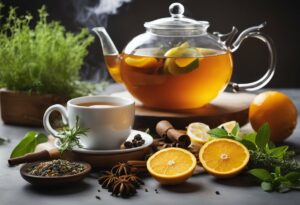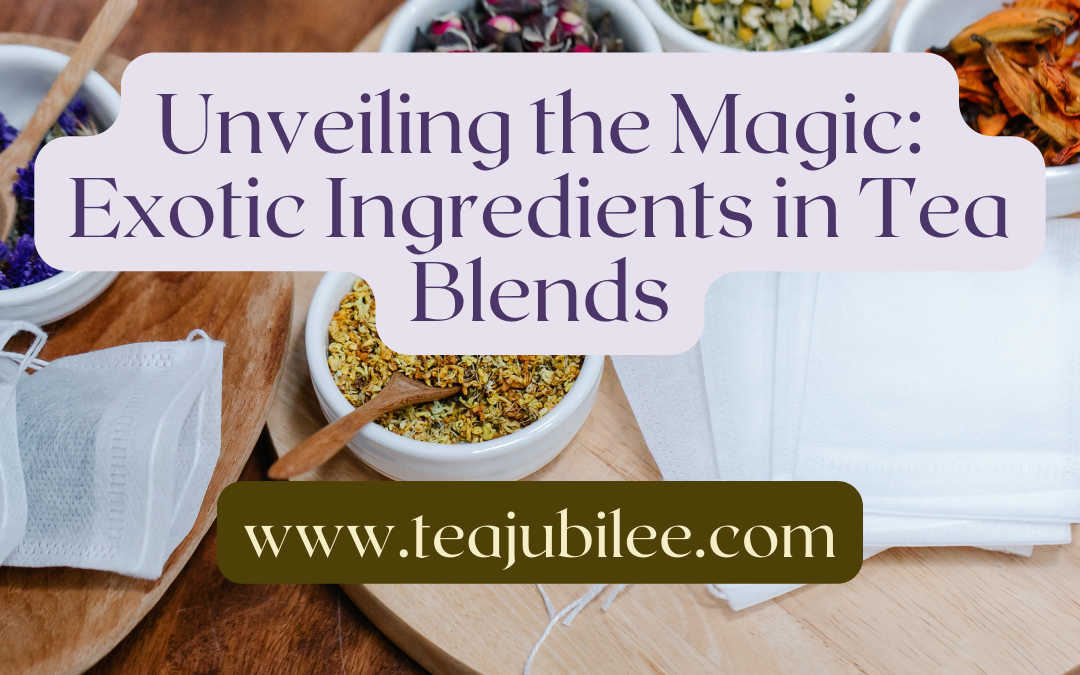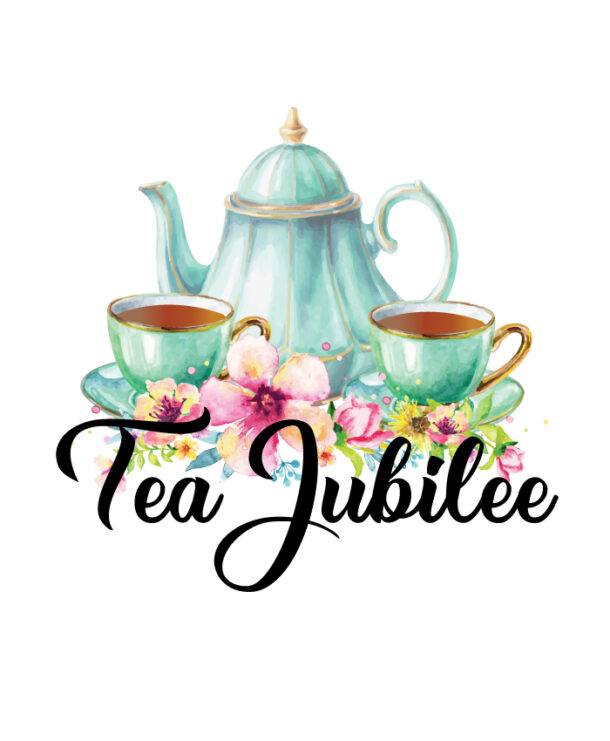==================
A Caveat and Affiliates
First off, a little caveat: within my articles you will find affiliate links, meaning if you buy them, I get a small commission. Your cost is not affected. In addition, I am an Amazon Associate and I earn from qualifying purchases on Amazon.
And yes, if I say that I recommend a product here, it means I truly believe it is a good product. I refuse to recommend any product that I have not researched and believe to be a good value.
Even better, I provide you with a very clear picture of the product, it’s use, and the probable value.
Earning your trust is important to me. I run this website myself and the commissions and donations help support the site.
Sound reasonable and fair enough? Let’s continue to the article.
==================
Contents
Exploring Exotic Ingredients In Tea Blends: A Guide to Uncommon Flavors
Are you ready to Explore Exotic Ingredients In Tea Blends? If so, welcome to Tea Jubilee! Here, I help you understand and enjoy the benefits of tea from everywhere, from China to England. I appreciate all kinds of teas.
Discover the unique flavors that will elevate your tea experience.
Tea has long been cherished for its comforting warmth and diverse flavors. It offers a universe of tastes ranging from the robust black teas that power morning routines to the delicate white teas that accompany quiet moments of reflection.
Within this spectrum lies a trend for adventurous palates: exotic blends incorporating unique ingredients, transforming the humble tea leaf into an extraordinary sensory experience.
These blends often include unexpected flavors, such as rare spices, tropical fruits, and even floral notes, that are not typically found in traditional tea recipes.
As a connoisseur exploring these eclectic tea blends, it’s important to consider the quality and origin of the tea leaves and the additional ingredients. A well-crafted exotic blend starts with high-quality tea leaves—green, black, oolong, or white—that serve as a foundation to elevate the unconventional add-ins.
The source of these leaves, along with the method of harvesting and processing, strongly influences the final taste.
When purchasing, examining the blend’s components for freshness and authenticity is essential. Authenticity ensures you’re enjoying the true essence of the exotic elements intended by the blender, while freshness guarantees the most vibrant and full-flavored cup.
Pay attention to details like the presence of whole ingredients versus flavorings—the more natural the blend, the better the quality. Also, check for certifications guaranteeing organic or fair-trade practices, as these can affect taste and ethical considerations.

Exotic Tea Blend Discoveries
In my quest to experience unique flavors, I’ve encountered various tea blends that incorporate exotic ingredients. These blends offer a journey through taste with unexpected combinations and rare components, elevating the humble tea leaf to a new level of enjoyment. The following list represents my top picks, each selected for their quality and the intriguing elements they bring to your teacup.
Maui Mango Blend
If you’re looking for a caffeine-free, tropical tea that can transport you to a sunny beach with every sip, the Maui Mango Blend is a must-try.
Pros
- Amazingly fresh and tropical flavors
- Beautifully packaged and resealable for freshness
- Supports a company with a charitable foundation
Cons
- It may be too sweet for some palates
- Loose leaf might require additional tea accessories
- Limited to 25 cups per pouch, which may not last long for avid tea drinkers
Since I opened the Tiesta Tea’s Maui Mango Blend pouch, the aroma alone has made me a fan. It’s as if a tropical breeze wafted through my kitchen carrying hints of pineapple and mango.
Not every day you find a fruit tea that makes you feel like you’re on vacation, but this one truly does the job.
Brewing this tea is like a bit of escape; the process is simple, and the result is consistent. I use 1.5 teaspoons per 8 ounces of water, steep for 5-7 minutes each time I get that perfect blend of zesty and sweet flavors.
It’s a vibrant, deep red cup that tastes just as good over ice—perfect for those warmer days.
What I truly appreciate about this tropical concoction is its versatility. I favor it as is, but sometimes, I add a hint of honey or sugar, which beautifully complements the natural fruitiness.
The fact that it’s caffeine-free means it’s my go-to even in the late evening, ensuring my moments of relaxation before bed are always delightful.
Lyon’s Exotic Tea Journey
I find Lyon’s Exotic Tea Journey an inspiring collection for seasoned tea lovers and those new to tea blending.
Pros
- Excellent variety of base teas and infusers for customized blending
- Elegant packaging suitable for gifting
- Comprehensive brewing instructions are provided for the perfect cup
Cons
- Premium prices may not fit all budgets
- The larger quantity of base teas would be desirable
- Limited total tea volume, considering the variety
Having experienced Lyon’s Exotic Tea Journey firsthand, I’m thrilled by the assortment and quality of the selection. It’s like taking a global tea tour from the comfort of my kitchen.
Every steep reveals new taste profiles, and the freedom to mix and match is wonderfully liberating. The floral chamomile and lavender notes fuse seamlessly with black tea’s robustness, creating a comforting blend perfect for winding down after a long day.
The packaging is truly gift-worthy. It displays the tins in a pleasing layout that excites at first glance. Receiving this as a present would delight any tea aficionado.
Lyon has clearly considered the aesthetics and practicality of their set, with labels that make it easy to craft your own signature brew.
The detailed instructions’ value shouldn’t be understated. The guide is an indispensable tool for those less experienced with loose-leaf blends. It helps maximize each ingredient’s potential, ensuring a delicious outcome every time.
However, as much as I appreciate the variety, I wish the base teas came in larger quantities. The set invites experimentation, which quickly depletes the more popular flavors.
Also, while it’s a visual treat that tastes exquisite, the overall quantity of tea provided is limited for its price.
Maui Mango Cold Brew
I highly recommend the Maui Mango Cold Brew for a tropical escape in your cup. Its ease of brewing and fruity taste are exceptional.
Pros
- It is packed with natural fruit flavors, and no artificial sweeteners are needed
- Extremely easy to prepare with cold brew packets, ideal for busy lifestyles
- Suitable for all ages due to its caffeine-free nature
Cons
- Some may find the fruity taste a bit overpowering
- It can be a little pricey compared to other teas
- A few may prefer the robust flavor of caffeinated tea blends
Just yesterday, I indulged in a glass of Maui Mango Cold Brew, and the experience was akin to being on a mini-vacation. The natural sweetness, bursting from the mango and pineapple pieces, was evident with every sip, and the subtle citrusy zest from the oranges made it all the more refreshing.
I’ve noticed these flavors rally enthusiasm even among those who aren’t typically tea drinkers, which is a testament to its universal appeal.
What’s remarkable about this blend is its simplicity of preparation. I just dropped a packet into a pitcher filled with cold water, left it to infuse in the fridge, and soon enough, a tantalizing tea was ready to be enjoyed.
This hassle-free process is perfect for when I’m juggling work and don’t have the luxury of hovering over a kettle.
However, balance is key, and while I adore the Maui Mango’s sweetness, some friends have commented it’s a bit much for their palate, especially if they lean towards more traditional tea blends. Yet, this doesn’t detract from the overall excellence of the product.
In terms of cost, Maui Mango Cold Brew is on the higher end, but you’re paying for quality ingredients that are visibly generous in each packet.
For those like me, watching their caffeine intake, the lack of it in this tea is a definite plus, though I understand this might dissuade the die-hard fans of a morning perk-up.
Tiesta Tea Fruit Frenzy
This trio is a must-try if you’re looking to indulge in a sensory explosion of exotic fruit flavors and embrace a healthier tea-drinking habit.
Pros
- Rich, authentic fruit flavors without the need for added sweeteners
- Loose leaf blend allows for a full sensory experience with each brew
- Contributing to social good through the Tiesta Tea Foundation
Cons
- It may not satisfy if you prefer traditional tea flavors
- Loose leaf format requires additional accessories for brewing
- The novelty of exotic blends could wear off for daily tea drinkers
Exploring the Fruit Frenzy Trio was like setting off a vibrant adventure with my taste buds. Swirling with the succulent tastes of peaches, cherries, and oranges, each blend transported me to the orchard in full bloom.
Without a doubt, these teas offered an upgraded experience compared to conventional tea bags. Watching the steeping process, witnessing the unfurling leaves, and inhaling the heady fragrances added another layer of enjoyment to my daily tea ritual.
These exotic blends from Tiesta Tea were not only about tantalizing flavors but also about their commitment to natural, fine ingredients that you can see. I found this particularly appealing as it’s far removed from the mystery contents of traditional tea bags.
What’s more, as someone who often adds sweeteners to my tea, I was pleasantly surprised by the natural sweetness of these blends, which eliminated the need for any extras.
Tiesta Tea’s impact goes beyond the cup; the company’s philanthropic initiative, the Tiesta Tea Foundation, resonates with me. It’s refreshing to support a brand that gives back, and this made each sip of the Fruit Frenzy Trio feel like a small contribution to a larger cause.
That said, for those less adventurous, the novelty of fruity blends might not be preferable as an everyday choice, but it’s certainly a delightful diversion from the usual tea options.
Tea Forte Exotic Green Mango Peach
I just savored a cup of Tea Forte’s Green Mango Peach tea, and I find it a remarkable blend for its distinctive taste and organic quality.
Pros
- Bursting with the natural sweetness of mango and the delicate tang of peach.
- A generous one-pound bag ensures a long-lasting supply of about 160-170 cups.
- The organic green tea leaves provide a refreshing and wholesome base.
Cons
- Some may find the peach notes not as prominent as expected.
- Tea enthusiasts with a preference for traditional flavors might find it too exotic.
- Packaging could be more robust to preserve the aroma for longer periods.
Lifting the Tea Forte Green Mango Peach pouch, the aroma is the first distinguishing sign of its exotic nature.
Opening the bag unleashes a scent profile that evokes the fragrant sweetness of mangoes meshed with a subtle hint of peach, setting the stage for an enriched green tea experience.
Each spoonful of loose leaves promises a refreshing brew steeped in flavors and a moment of tranquility.
The tea reveals its true character upon steeping – a harmonious blend of green tea’s earthiness with a fruity overlay that dances on the palate.
The taste is cleanly green but with an unexpected twist thanks to the fruity elements.
I appreciate the balance achieved here; it’s a stimulating diversion from standard green tea offerings without overshadowing its inherent qualities.
What stands out is both the quantity and the quality of Tea Forte’s offering.
With a full pound of organic leaves, one realizes that every cup, whether savored in a quiet morning ritual or presented to friends, is part of a larger canvas of sensory experiences.
This tea has become part of my daily habit, and its flavor profile is a reminder that even the simplest of routines can be uplifted with a touch of the exotic.
Buying Guide
Understanding Tea Blend Ingredients
When selecting exotic tea blends, I prioritize understanding the ingredients.
Exotic ingredients range from herbs and spices to fruit pieces and flower petals.
I check the packaging for a complete list of ingredients, ensuring they are natural and sourced sustainably.
Quality and Freshness
The quality of tea is paramount.
I look for tea blends with whole leaves, as they retain their essential oils and flavor better than broken leaves or dust in standard tea bags.
Freshness is also crucial; tea should be packed soon after harvesting and sealed correctly to preserve its aroma and taste.
Flavor Profile
Teas come with diverse flavor profiles.
Depending on my preference, I choose blends that offer a balance of flavors that appeal to me, whether floral, fruity, spicy, or earthy notes.
Understanding the base tea (green, black, white, oolong, pu-erh) helps me anticipate the overall taste.
Caffeine Content
Depending on when I plan to enjoy my tea, caffeine content can be a deciding factor.
For a morning pick-me-up, I might opt for blends with a higher caffeine content, while for evenings, I prefer herbal blends with little to no caffeine.
Ethical Sourcing
Ethical sourcing is essential.
I ensure that the tea comes from farms that practice fair labor and sustainable farming.
Similarly, organic certification can be a preference for those looking to avoid pesticides.
Packaging
Lastly, packaging can affect the tea’s shelf life.
I prefer airtight containers or pouches with a proper seal to maintain freshness.
Some packaging might also be resealable, a bonus for preserving the tea between uses.
| Consideration | Details to Look For |
|---|---|
| Ingredients | Natural, sustainably sourced |
| Leaf Type | Whole leaf for quality |
| Freshness | Properly sealed, recently packed |
| Flavor Profile | Match with personal preference |
| Caffeine Content | Suitable for intended use time |
| Ethical Sourcing | Fair labor, sustainable practices |
| Packaging | Airtight, resealable |
Frequently Asked Questions
In exploring exotic ingredients in tea blends, I’ve encountered several questions that tea enthusiasts frequently ask. These center around creating the perfect balance of flavors and aromas.
What herbs complement each other to create a balanced tea concoction?
I’ve found that chamomile and lavender blend well for their soothing qualities, while mint and lemongrass offer a refreshing zest.
It’s essential to consider each herb’s flavor profile and how they interact.
Which component of tea is responsible for its aromatic properties?
The volatile oils within tea leaves are mainly responsible for a tea’s aroma.
Factors like the leaf’s age, processing methods, and additional aromatic ingredients such as cinnamon or cardamom greatly influence the fragrance of the tea.
What guidelines should one follow when crafting homemade flavored tea mixtures?
When I make homemade tea blends, I ensure that the base tea is of high quality and that any added flavors are natural and complementary.
I also pay attention to the freshness of my ingredients, as this significantly affects the taste.
What is the ideal proportion of ingredients to use in making tea blends?
The ideal proportion usually depends on personal preference. Still, a general guideline is to start with roughly 3 parts of the base tea to 1 part of the combined additional ingredients, then adjust to taste.
How can one infuse a unique flavor into a tea blend without overpowering the tea’s natural essence?
I recommend starting with small amounts of any strong ingredient and gradually increasing them.
It’s vital to taste the blend frequently and make incremental changes. This ensures the natural essence of the tea remains prominent.
Which exotic ingredients can be introduced to traditional tea blends to enhance their taste and aroma?
Exotic ingredients such as dried fruits, particularly berries, can be mixed with traditional teas to enhance flavor profiles. Rose petals, saffron, and vanilla pods can also be added to improve the taste and aroma.
Meanwhile, spices like cardamom and cloves can add complexity to the aroma.
Overall, the teas in this article are great. If you like teas with a hint of sweetness and want to try something brand new,
More From Tea Jubilee
The Top 10 Flavors To Mix In Tea Blends
The Ultimate Guide To Herbal Tea Blends
The Health Benefits of Herbal Teas
Vanilla and Cinnamon Tea Latte
And that’s all for today! Thank you for reading my post about Exploring Exotic Ingredients In Tea Blends. Don’t forget to check out the link to the teas I love to sip on daily. I look forward to hearing your thoughts on this post.
Have a great day!









